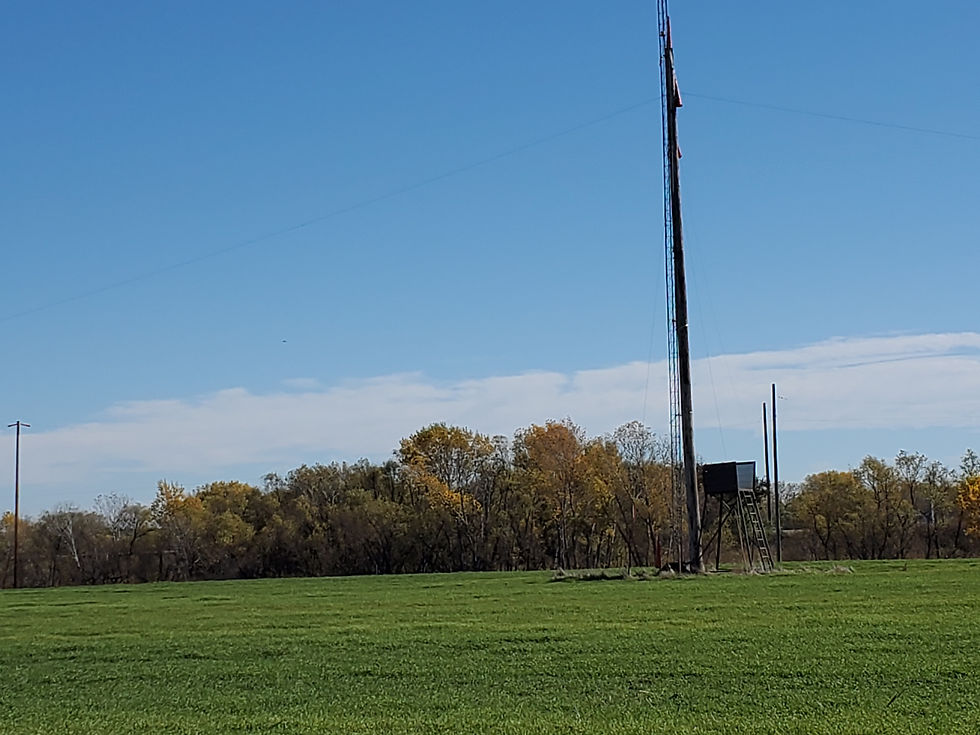The K0UO Comprehensive Guide to Rhombic HF Antennas
- skylarkcolo

- Nov 7
- 7 min read
Updated: 2 minutes ago

High-frequency (HF) communication plays a crucial role in connecting people and systems across vast distances. Among the many antenna designs available, the rhombic HF antenna stands out for its unique characteristics and effectiveness in long-distance communication. This post explores why rhombic HF antennas remain a valuable choice for radio amateurs, broadcasters, and communication professionals who need reliable, high-performance antennas.
What Is a Rhombic HF Antenna?
A rhombic HF antenna is a wire antenna shaped like a diamond or rhombus, typically made from four straight wires connected at the corners. It is a directional antenna designed to transmit and receive signals over long distances by focusing radio waves in a specific direction.
The antenna’s shape and length are carefully calculated based on the wavelength of the HF signals it is intended to handle. Usually, the rhombic antenna is mounted high above the ground on poles or towers, with its wires stretched tight to maintain the diamond shape.
How Rhombic Antennas Work
Rhombic antennas operate by directing radio waves along the length of the diamond shape. The wires act as radiators and reflectors, creating a strong, focused beam of radio energy. This directional focus increases the antenna’s gain, allowing it to send and receive signals much farther than omnidirectional antennas.
The antenna’s length is often several wavelengths long, which helps reduce signal loss and improves efficiency. The angle of the rhombus and the height above ground influence the antenna’s radiation pattern, allowing operators to tailor the antenna for specific communication paths.
Traveling Wave Antennas: A Rhombic and V Beams are Traveling wave antennas and are characterized by their ability to radiate in one direction.
Traveling wave antennas are a category of antennas designed to support waves that travel along their length rather than standing waves that form in typical resonant antennas. In HF bands, these antennas are often used to achieve broad bandwidth and directional radiation patterns.
Unlike traditional antennas such as dipoles or monopoles, which rely on standing waves and resonance at specific frequencies, traveling wave antennas allow the radio wave to move continuously along the antenna structure. This feature reduces signal reflections and enables more consistent performance across a wide frequency range.
Radiofrequency current travels through the antenna in a single direction. This is in contrast to resonant antennas, where the current travels in both directions. The main radiating mechanism in traveling wave antennas is a traveling wave on a guiding structure.
Common types include the Beverage receive antenna, V Beam Arrays (Vee Beam), axial-mode helical antenna, and Rhombic antenna. These antennas are often used in radio and telecommunication systems due to their wide bandwidth and ability to transmit signals over long distances.

Advantages of Rhombic HF Antennas
Don't underestimate the performance of the Rhombic, unless you have personally built and used one. Because of their excessive size (area) covering many acres, you see their real advantage of thousands of feet of wire in the air, which creates receive signal diversity, by capturing signals at different times and different angles, vastly eliminating fading QSB, and firing out the transmitted RF in the same way. Traveling wave antennas are very unique and unlike many other antenna in common use
High Gain and Directionality
One of the most significant benefits of rhombic antennas is their high gain. Gain refers to how well an antenna focuses energy in a particular direction. Rhombic antennas can achieve gains of 12 to 18 dB or more, which means they can transmit signals much farther than simple dipole antennas.
K0UO Rhombic antenna farm, is home of the Re-entrant Rhombic, which is 90% efficient by re-phasing the power instead of heating up termination resistors. We are using AI which is now becoming an advanced tool in analyzing, developing, and expanding research in RF and antennas.
This directionality also reduces interference from unwanted sources, improving signal clarity. For example, a rhombic antenna aimed toward Europe from North America can focus its energy in that direction, minimizing noise from other directions.
Wide Bandwidth
Rhombic antennas cover a broad frequency range without needing complex tuning. This wide bandwidth makes them suitable for various HF bands, from 3 MHz up to 30 MHz. Operators can use the same antenna for multiple communication modes and frequencies, which adds flexibility.
Simple Construction and Low Cost
Despite their size, rhombic antennas are relatively simple to build. They require only wire, insulators, and support poles or towers. This simplicity keeps costs low compared to more complex antenna arrays or large directional antennas.
For amateur radio enthusiasts, this means they can build an effective long-distance antenna with modest resources and basic materials.
Low Noise Reception
Rhombic antennas tend to pick up less man-made noise because of their directional nature. By focusing on a specific direction, they reject signals and interference from other angles. This feature improves reception quality, especially in noisy urban environments or during times of high atmospheric noise. t
At his time K0UO is the only Rhombic station using re-phasing. These are the largest wire antennas in use by an amateur radio stations with 14 to +18 dBd of gain. Signal to noise is excellent at the K0UO Rhombic farm.
High Power Handling

These antennas can handle high transmitter power levels without damage, making them suitable for commercial broadcasting and military communication applications. Their wire construction and spacing help dissipate heat and reduce the risk of arcing.
HF Rhombic traveling wave antennas provide a powerful solution for long-distance and wideband communication needs. Their ability to support traveling waves allows for broad frequency coverage, directional radiation, and high gain. While they require more space and careful installation than some other antennas, their benefits make them valuable for broadcasters, amateur radio operators, military users, and researchers alike.
Practical Applications of Rhombic HF Antennas
Amateur Radio Long-Distance Contacts
Shortwave Broadcast station, DOD, and amateur radio operators use rhombic antennas to make long-distance contacts, known as DXing. The antenna’s high gain and directionality help overcome signal fading and interference, enabling clearer communication over thousands of miles.
International Broadcasting
Rhombic antennas have been widely used by international broadcasters to send radio programs across continents. Their ability to focus energy toward target regions ensures strong, reliable signals for listeners far away.
Military and Government Communication
Military and government agencies have employed rhombic antennas for secure, long-range HF communication. Their robustness and high power handling make them suitable for critical communication links in remote areas.
Scientific Research and Remote Stations
Remote research stations, such as those in polar regions, use rhombic antennas to maintain communication with the outside world. The antenna’s reliability and long-distance capability are essential in harsh environments where other communication methods may fail.
Design Considerations for Rhombic HF Antennas

Size and Space Requirements
Rhombic antennas require significant space because their length is several wavelengths long. For example, at 10 MHz (wavelength about 30 meters), the antenna might be 120 meters or more in total length. This requirement limits their use in small or urban properties.
Support Structures
The antenna needs sturdy support poles or towers to keep the wires taut and maintain the rhombic shape. These supports must withstand weather conditions such as wind, rain, and ice.
Grounding and Safety
Proper grounding is essential to protect the antenna and equipment from lightning strikes. Safety measures should be in place to prevent accidental contact with the wires, especially in public or accessible areas.
Feed Point and Matching
The antenna feed point is usually at one corner of the rhombus, where the transmission line connects. Matching the antenna impedance to the transmission line is necessary to minimize signal loss. This often involves using baluns or matching networks.
Comparing Rhombic Antennas to Other HF Antennas
| Antenna Type | Gain | Bandwidth | Size | Directionality | Cost |
|--------------------|---------------|-----------------|---------------|-----------------|----------------|
| Rhombic | High (12-18 dB) | Wide (3-30 MHz) | Large | Highly directional | Low |
| Dipole | Moderate (2-3 dBi) | Narrow | Small | Omnidirectional | Very low |
| Yagi-Uda | Moderate to High (6-10 dBi) | Narrow | Medium | Directional | Moderate |
| Log-Periodic | Moderate (6-10 dBi) | Wide | Medium | Directional | Moderate |
Rhombic antennas offer higher gain and wider bandwidth than many common HF antennas but require more space. Yagi antennas provide good gain with smaller size but cover narrower frequency ranges. Dipoles are simple and small but lack directionality and gain.
Tips for Building and Using Rhombic HF Antennas
Choose the right location: Open, elevated areas free from obstructions improve performance.
Use quality wire: Copper, copper-clad, or large diameter galvanized coated wire rope cable offers good conductivity and durability.
Maintain proper tension: Keep wires tight to preserve the rhombic shape and prevent sagging.
Experiment with angles: Adjust the rhombus angles to optimize the radiation pattern for your target direction.
Regular inspection: Check for corrosion, broken insulators, or loose connections to maintain efficiency.
Final Thoughts on Rhombic HF Antennas
Rhombic HF antennas remain a powerful tool for long-distance communication. Their high gain, wide bandwidth, and relatively simple construction make them attractive for many users who need reliable, focused signals over thousands of miles.
While they require space and careful setup, the benefits often outweigh these challenges. Whether you are an amateur radio operator aiming for distant contacts or a broadcaster reaching international audiences, a rhombic antenna can deliver strong, clear communication.
THE K0UO Rhombics Antenna has 4 very large arrays on 100 foot pole.
To put it in perspective, my four rhombic antennas each cover an area equal to five football fields, or about 7 acres each, and over 3.5 acres for each of the 3 V-Beams (You need acres). These are the world's largest ham radio wire antenna arrays now in use I'm very fortunate to to be able to use over 1200 acres surrounding the antenna site, for far field HF antenna measurements, for testing the performance of these and other antennas. We are using AI which is now becoming an advanced tool in analyzing, developing, and expanding research in RF and antennas.

K0UO – Kiowa, Kansas, USA
Owner/Operator: Steven Walz, call sign K0UO and V31KW












Excellent information reading throughout your whole blog and you put a lot of effort into building those things keep the old equipment on the air like W6 a.m. and others